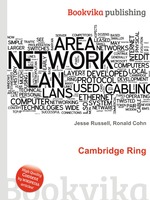Cambridge Ring
Jesse Russell Ronald Cohn
бумажная книга
High Quality Content by WIKIPEDIA articles! The Cambridge Ring was an experimental local area network architecture developed at the Cambridge University Computer Laboratory in the mid-late 1970s and early 1980s. It used a ring topology with a theoretical limit of 255 nodes (though such a large number would have badly affected performance), around which cycled a fixed number of packets. Free packets would be "loaded" with data by a machine wishing to send, marked as received by the destination machine, and "unloaded" on return to the sender; thus in principle there could be as many simultaneous senders as packets. The network ran over twin twisted-pair cabling (plus a fibre-optic section).


